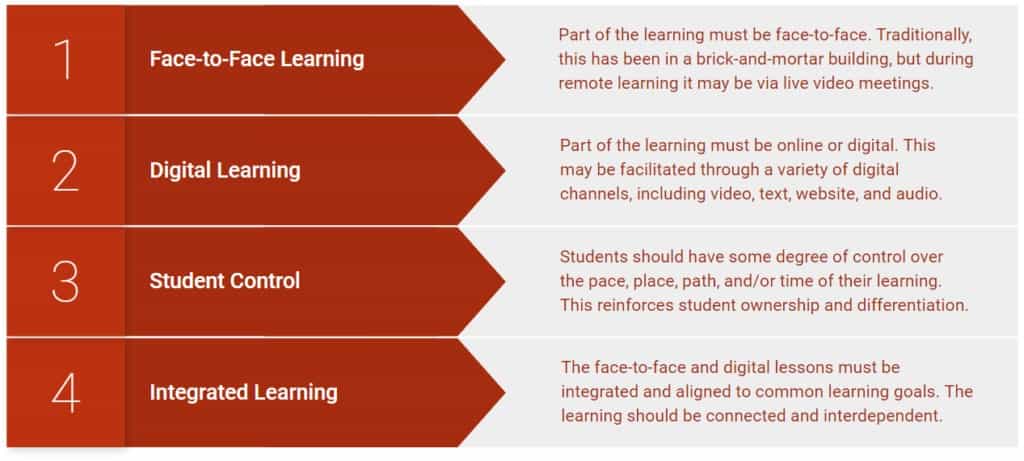
What are you blending when you speak about blended learning? You are combining face to face classroom learning with an instructor and online or computer driven learning. Let’s learn a little more about this concept of learning.
In the 1960’s, technology-based training emerged as an alternative to instructor-led training. One of the major advantages of blended learning is that it offers economies of scale. Online instruction can be delivered to almost any number of students while there is a natural constraint to how many students an instructor can teach face-to-face.
Overview: What is blended learning?
In the beginning, the term blended learning was vague, encompassing a wide variety of technologies and pedagogical methods in varying combinations. In 2006, the term became better defined with the publication of the Handbook of Blended Learning by Bonk and Graham. Graham defined blended learning systems as learning systems that “combine face-to-face instruction with computer mediated instruction”.
In a report titled Defining Blended Learning, Norm Friesen, Professor in Educational Technology, suggested that blended learning “designates the range of possibilities presented by combining Internet and digital media with established classroom forms that require the physical co‐presence of teacher and students”.
While the definition of blended learning is still not strictly defined, there are several different models which are variations of blended learning. They are:
- Face-to-face driver – The teacher drives the instruction and augments with digital tools.
- Rotation – Students cycle through a schedule of independent online study and face-to-face classroom time.
- Flex – Most of the curriculum is delivered via a digital platform and teachers are available for face-to-face consultation and support.
- Labs – All of the curriculum is delivered via a digital platform but in a consistent physical location. Students usually take physical classes in this model as well.
- Self-blend – Students choose to augment their physical learning with online course work.
- Online driver – Students complete an entire course through an online platform with possible teacher check-ins. All curriculum and teaching are delivered via a digital platform and face-to-face meetings are scheduled or made available if necessary.
Some of the advantages of blended learning could be:
- Blended instruction is reportedly more effective than purely face-to-face or purely online classes. Many say that blended learning methods can also result in high levels of student achievement more effectively than face-to-face learning.
- By using a combination of digital instruction and one-on-one face time, students can work on their own with new concepts which frees teachers to circulate and support individual students who may need individualized attention.
- Blended learning also has the potential to reduce educational expenses.
- This virtual learning environment helps connect professors with students without physically being present.
Some disadvantages of blended learning may be:
- Unless successfully planned and executed, blended learning could have disadvantages in technical aspects since it has a strong dependence on the technical resources or tools with which the blended learning experience is delivered.
- While this type of learning does offer students the ability to go online when necessary, or learn from anywhere, there is no guarantee that each student will have access to the tools that they need to learn on the computer. Another problem that may arise is unreliable internet connectivity.
- IT literacy can serve as a significant barrier for students attempting to get access to the course materials, making the availability of high-quality technical support paramount.
- From an educator’s perspective it has been noted that providing effective feedback with blended learning is more time-consuming when compared to traditional assessments.
An industry example of blended learning
As a result of the COVID-19 pandemic, the company’s Six Sigma Green Belt training had to transition away from only classroom training to a blended learning model. The Master Black Belt (MBB) responsible for training had to transfer the training content used in the classroom to an online format.
Classes were scheduled and presented via a Zoom format. The class was facilitated by the MBB live using Zoom. Students were able to review the material, do their homework and take exams offline. Coaching and individual tutoring was available as scheduled Zoom meetings.
Frequently Asked Questions (FAQ) about blended learning
What are some barriers to blended learning for adults?
Some barriers to implementing blended learning for adults fall into four areas: 1) inadequate tools designed specifically for adult learners, 2) lack of user comfort with technology, 3) logistical barriers related to internet and tool access, and 4) resistance to technology driven learning.
What are some best practices for blended learning?
Some best practices include:
- Online office hours. Some students are intimidated by the classroom setting.
- Flip the classroom where non-interactive activities are shifted to the Internet. Students can watch a pre-recorded lecture, presentation or instructional video via their online learning platform before coming to class.
- Provide instant feedback with e-learning tools.
- Use performance tracking to improve content.
- Create an interactive community of online learners.
What are the key elements of blended learning?
The graphic below illustrates the key elements of blended learning:
